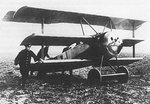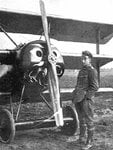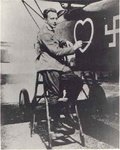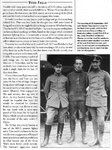Werner Voss (April 13, 1897–September 23, 1917) was a World War I German fighter pilot and ace. Born in Krefeld, the first son of an industrial dyer, Voss was at one time a friend and rival of the renowned Manfred von Richthofen, but lacked the Red Baron's aristocratic background.
Enlisting in the 2nd Westphalian Hussar regiment Nr. 11 in 1914, like many cavalrymen he eventually transferred to the Luftstreitkräfte or German Air Service, learning to fly at Egelsberg near his home town. Evidently a natural pilot, upon graduating he was immediately enrolled as an instructor, before departing to the front where he had to serve with Kampfstaffel 20 of Kampfgeschwader IV as an observer before he could earn his pilot's badge. Transferring to scout aircraft, he was posted to Oswald Boelcke's Jasta (Jagdstaffel) 2 where he flew as Manfred von Richthofen's wingman. At the age of only 18 years, he scored his first victory on November 27, 1916. Flying an Albatros D.III scout aircraft decorated with an Iron cross and heart motifs (for good luck), he achieved 38 credited victories.
He was subsequently promoted to temporary commands at Jastas 5, 29, and 14 before moving to a permanent command at Jasta 10 as part of Richthofen's Jagdgeschwader I (JG I) (or "Flying Circus" as it later became known to the Allies). Having tested one of the F.1 prototypes (103/17, Wk. Nr.1730) of the Fokker Dr.I triplane scout for Anthony Fokker, Voss evidently adapted his flying style to the rotary engined triplane, being credited with a further 10 victories with this new aircraft, bringing his total to 48 aircraft. He adorned the cowling of his new aircraft by painting two eyes, eyebrows, and a moustache (a face motif thought by some to derive from Japanese kites). Voss was known for being a loner and an inspirational, rather than effective, leader (modern writers often describe him as 'mercurial').
He was finally shot down after single-handedly engaging in combat with eight Royal Aircraft Factory SE5s of 60 and 56 Squadrons of the Royal Flying Corps on September 23, 1917, over Poelcappelle. Although the SE5's were flown by some of the RFC's best aces (James McCudden, Richard Maybery, Keith Muspratt, Reginald Hoidge, Arthur Rhys Davids and Hammersley) by exploiting the triplane's superior rate of climb and its ability to slip turn, Voss continually outflew his opponents and fought bravely, before succumbing to an attack generally credited to Lieutenant Arthur Rhys Davids of 56 Squadron. His aircraft crashed near Plum Farm north of Frezenberg in Belgium. Only the rudder, cowling, and parts of the undercarriage were salvaged and the aircraft was the subject of a report by 2nd Lieutenant G. Barfoot-Saunt.
The famous Fokker Dr.I silver-grey of Voss during his last battle.
McCudden's Se5 plane during the dogfight when Voss was killed.One of the British pilots he fought against that day, Major James McCudden, a recipient of the V.C. who would become a leading English ace of World War I before being himself killed in an aircraft accident in the summer of 1918, expressed sincere regret at his death; "His flying was wonderful, his courage magnificent and in my opinion he was the bravest German airman whom it has been my privilege to see fight."
Enlisting in the 2nd Westphalian Hussar regiment Nr. 11 in 1914, like many cavalrymen he eventually transferred to the Luftstreitkräfte or German Air Service, learning to fly at Egelsberg near his home town. Evidently a natural pilot, upon graduating he was immediately enrolled as an instructor, before departing to the front where he had to serve with Kampfstaffel 20 of Kampfgeschwader IV as an observer before he could earn his pilot's badge. Transferring to scout aircraft, he was posted to Oswald Boelcke's Jasta (Jagdstaffel) 2 where he flew as Manfred von Richthofen's wingman. At the age of only 18 years, he scored his first victory on November 27, 1916. Flying an Albatros D.III scout aircraft decorated with an Iron cross and heart motifs (for good luck), he achieved 38 credited victories.
He was subsequently promoted to temporary commands at Jastas 5, 29, and 14 before moving to a permanent command at Jasta 10 as part of Richthofen's Jagdgeschwader I (JG I) (or "Flying Circus" as it later became known to the Allies). Having tested one of the F.1 prototypes (103/17, Wk. Nr.1730) of the Fokker Dr.I triplane scout for Anthony Fokker, Voss evidently adapted his flying style to the rotary engined triplane, being credited with a further 10 victories with this new aircraft, bringing his total to 48 aircraft. He adorned the cowling of his new aircraft by painting two eyes, eyebrows, and a moustache (a face motif thought by some to derive from Japanese kites). Voss was known for being a loner and an inspirational, rather than effective, leader (modern writers often describe him as 'mercurial').
He was finally shot down after single-handedly engaging in combat with eight Royal Aircraft Factory SE5s of 60 and 56 Squadrons of the Royal Flying Corps on September 23, 1917, over Poelcappelle. Although the SE5's were flown by some of the RFC's best aces (James McCudden, Richard Maybery, Keith Muspratt, Reginald Hoidge, Arthur Rhys Davids and Hammersley) by exploiting the triplane's superior rate of climb and its ability to slip turn, Voss continually outflew his opponents and fought bravely, before succumbing to an attack generally credited to Lieutenant Arthur Rhys Davids of 56 Squadron. His aircraft crashed near Plum Farm north of Frezenberg in Belgium. Only the rudder, cowling, and parts of the undercarriage were salvaged and the aircraft was the subject of a report by 2nd Lieutenant G. Barfoot-Saunt.
The famous Fokker Dr.I silver-grey of Voss during his last battle.
McCudden's Se5 plane during the dogfight when Voss was killed.One of the British pilots he fought against that day, Major James McCudden, a recipient of the V.C. who would become a leading English ace of World War I before being himself killed in an aircraft accident in the summer of 1918, expressed sincere regret at his death; "His flying was wonderful, his courage magnificent and in my opinion he was the bravest German airman whom it has been my privilege to see fight."









